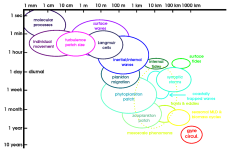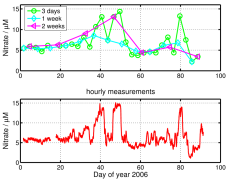

Chemical in situ sensors
The majority of chemical measurements in sea water are still based
on water samples taken with bottles or pumps that are analysed later in
the lab. With this method neither small scale processes or transient
events can be resolved adequately nor can long term datasets of
chemical variability be gained from long term stations or moorings. To
fill these gaps chemical in situ sensors are needed that exhibit
similar spatial and temporal resolution as the physical sensors (e.g.
for conductivity and temperature). In the long term these chemical in
situ sensors should reach the same accuracy, precision and resolution
as the analysis in the lab. However, high resolution in situ
measurements with reduced accuracy and precision can also give valuable
hints at the involved processes and therefore guide an optimized
sampling strategy.
There are various approaches in the development of new chemical sensors
that can be divided into two main groups:
1. Miniaturization of wet chemical
analysers
For the deployment on a variety of platforms wet chemical analysers
have to be optimized for minimum power and reagent consumption. To this
end small industrial fluidic components such as solenoid pumps and
valves are used (e.g. in the Fe/Mn analyser) together with small volume
absorption cells. A further step is the use of microfluidic MEMS
components. MEMS (Micro-Electro-Mechanical Systems) are based on
methods of the electronics industry, where mechanical structures are
etched into silicon or other
substrates and these structures are combined into microfluidic
components (e.g. pumps, valves, mixers etc.). Together with
microelectronics and microoptics these components can be put together
into a microfluidic analyser.
2. Physical-chemical methods
Sensing mechanisms that don't need reagents are ideal for longer term
deployments of chemical sensors. Examples for this kind of methods are
opt(r)odes, direct optical absorption measurements and
(micro)-electrodes.
One of our tasks for the development of new oceanographic chemical sensors is the search of new technologies developed in various fields, e.g. for industrial sensors. The potential of these technologies for an application for oceanographic sensors has to be evaluated with special consideration of the special demands of the underwater environment with typically low concentrations of analyte in the complex mixture that is seawater. Together with the technology leaders we are working on the adaption and modification to bring new technologies in the sea.
Members
Working Group Leader:
Post-Doc:
Christian Gehm
Technical Staff:
PhD Student:

